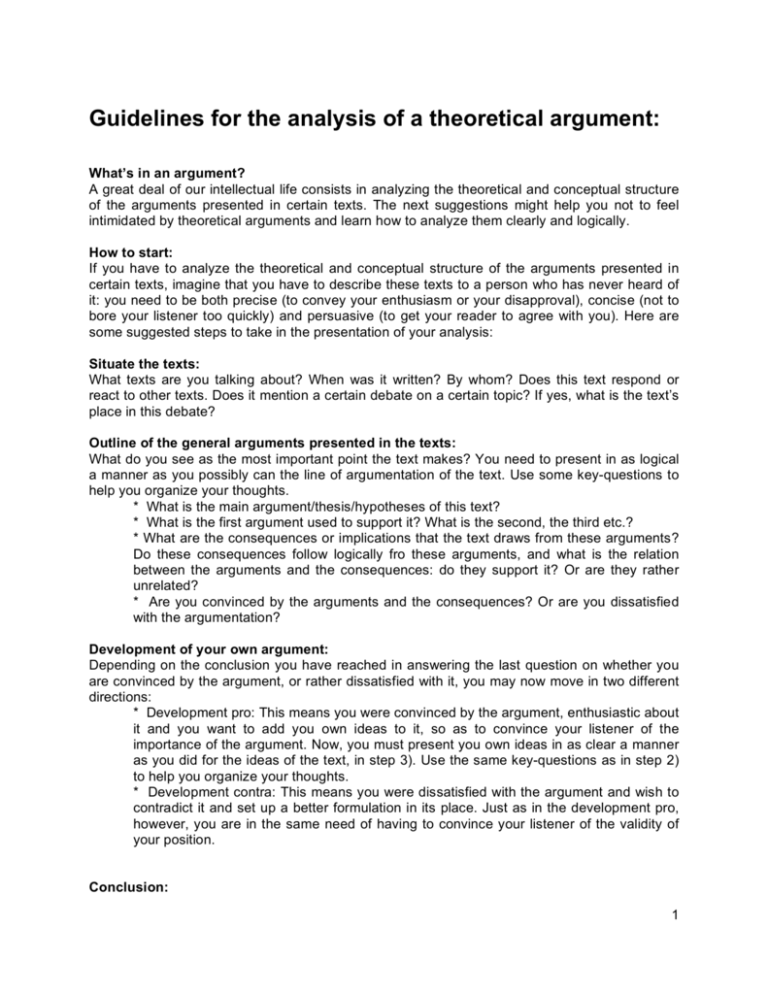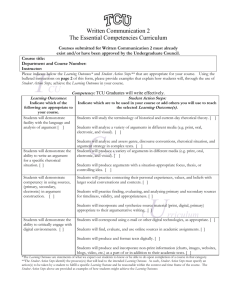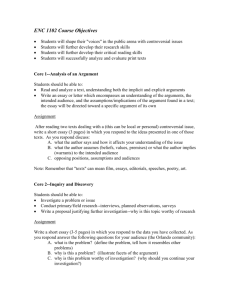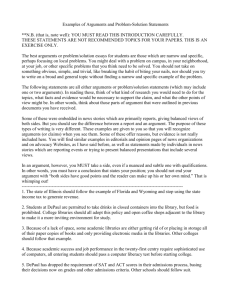Guidelines for the analysis of a theoretical argument:
advertisement

Guidelines for the analysis of a theoretical argument: What’s in an argument? A great deal of our intellectual life consists in analyzing the theoretical and conceptual structure of the arguments presented in certain texts. The next suggestions might help you not to feel intimidated by theoretical arguments and learn how to analyze them clearly and logically. How to start: If you have to analyze the theoretical and conceptual structure of the arguments presented in certain texts, imagine that you have to describe these texts to a person who has never heard of it: you need to be both precise (to convey your enthusiasm or your disapproval), concise (not to bore your listener too quickly) and persuasive (to get your reader to agree with you). Here are some suggested steps to take in the presentation of your analysis: Situate the texts: What texts are you talking about? When was it written? By whom? Does this text respond or react to other texts. Does it mention a certain debate on a certain topic? If yes, what is the text’s place in this debate? Outline of the general arguments presented in the texts: What do you see as the most important point the text makes? You need to present in as logical a manner as you possibly can the line of argumentation of the text. Use some key-questions to help you organize your thoughts. * What is the main argument/thesis/hypotheses of this text? * What is the first argument used to support it? What is the second, the third etc.? * What are the consequences or implications that the text draws from these arguments? Do these consequences follow logically fro these arguments, and what is the relation between the arguments and the consequences: do they support it? Or are they rather unrelated? * Are you convinced by the arguments and the consequences? Or are you dissatisfied with the argumentation? Development of your own argument: Depending on the conclusion you have reached in answering the last question on whether you are convinced by the argument, or rather dissatisfied with it, you may now move in two different directions: * Development pro: This means you were convinced by the argument, enthusiastic about it and you want to add you own ideas to it, so as to convince your listener of the importance of the argument. Now, you must present you own ideas in as clear a manner as you did for the ideas of the text, in step 3). Use the same key-questions as in step 2) to help you organize your thoughts. * Development contra: This means you were dissatisfied with the argument and wish to contradict it and set up a better formulation in its place. Just as in the development pro, however, you are in the same need of having to convince your listener of the validity of your position. Conclusion: 1 The classical procedure of a conclusion consists in: * Summarizing in as concise a manner as possible the position you defended before. * Compare it to the arguments made in the text to stress the superiority of the line you are opposing to it, or so as to add more support to the arguments. Do not feel intimidated by all this: after all, in the "Symposium", Plato describes the woman philosopher Diotima as the true inventor of the love of knowledge and the passionate pursuit of intellectual beauty and justice, which is what the life of the mind is all about. Feminist scholarship has added to Diotima a long list of women thinkers, whose work has helped us further on understanding the infinite possibilities of clear thinking. I hope you will follow their example! 2








